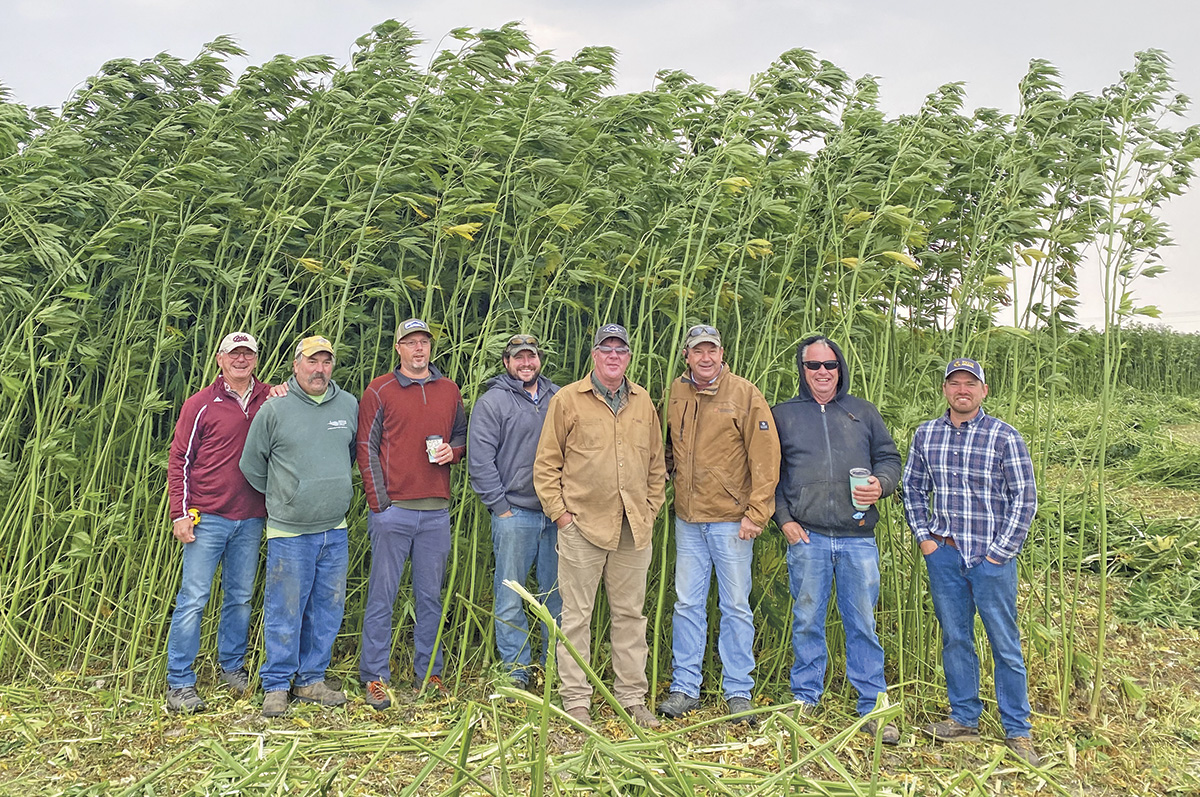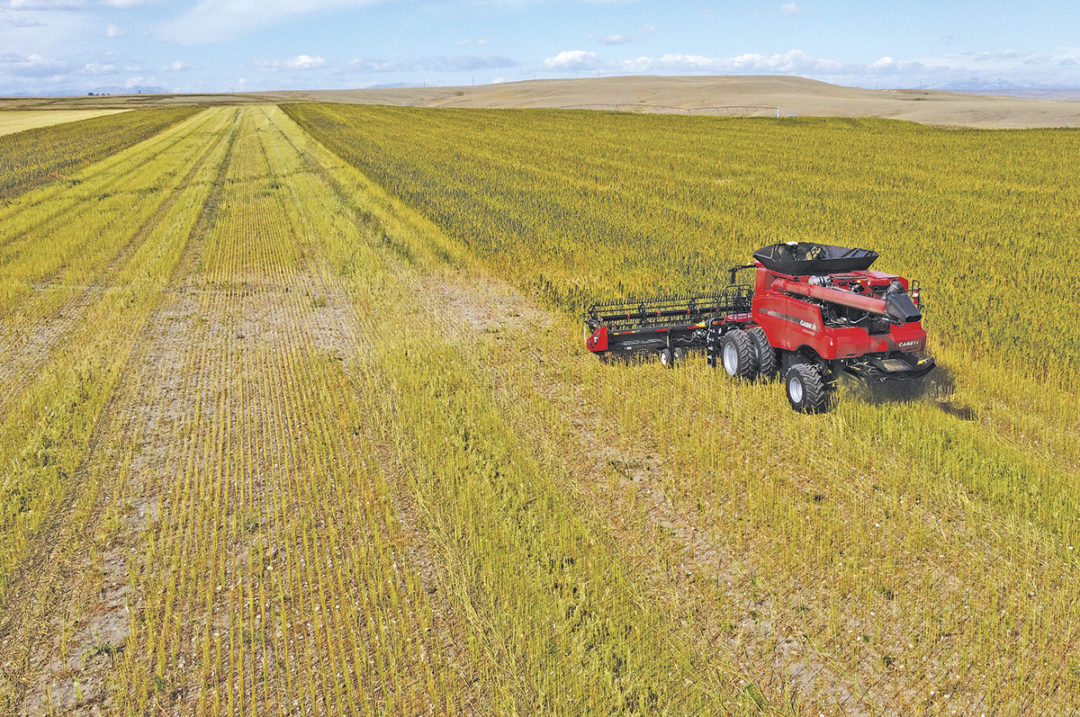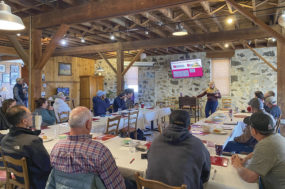The 2018 Farm Bill gave states the authority to produce hemp but left regulation and licensing to state agriculture departments. Now, with Idaho State Department of Agriculture offering licensing and certification in 2022, Idaho producers are finally able to apply to produce the crop. But what are the myths surrounding hemp – what have you heard and not heard?
Local Idaho producers exploring hemp opportunities gathered in Buhl recently to hear from specialists in Montana growing the fiber and grain varieties. IND HEMP, a Montana-based company that has grown hemp since 2014 (as part of a pilot project) had their agronomist, Ben Brimlow, address fiber hemp first.
Fiber hemp
Fiber hemp was used historically to form a canvas for ship sails and was also used to make the first pair of Levi Strauss jeans. Fiber hemp is developed to maximize biomass and, under irrigation, can reach heights of 15 to 20 feet. Dryland hemp can exceed 8 feet in height depending on annual precipitation. The value of this plant is not in the seedhead but is in the fiber within the woody stalk.
Planting happens mid-April through May, at a rate of 800,000 to 1 million plants per acre (30 plants per square foot) with narrow row spacing – drilled or even broadcast planted. Fiber hemp loves heat, so generally, Brimlow said, other crops on the farm are usually planted first and then the hemp is drilled.
The plant puts down a hybrid root system, with a primary taproot that can extend 12 inches or more and a branching of smaller roots nearer the surface, somewhat like a corn plant. It’s an efficient water user, Brimlow said, and the density of the planting helps it become a dense canopy early as well. This canopy density creates a microclimate for efficient water use. The canopy also shelters weeds, minimizing growth by restricting sunlight – so although weeds appear, they are choked out.
Brimlow said fiber hemp is a one-cut system at present. Once the stalk is cut below the first leaf joint, the plant is unable to regrow. Harvest begins in mid-August. Brimlow said the system that has worked best for them in Montana is to use a 1940s-style sickle mower pull-behind to lay the stalks flat. The self-propelled swathers and disc mowers, he said, often caused the stalks to wrap up in the machines.
As the crop lays in the field after cutting, it goes through a “retting” or curing process where microbes decompose the pectins to allow the fibers to separate from the woody core. Retting requires about 30% moisture. Retting at 68ºF requires seven to eight days to achieve. At 54ºF, 15 to 17 days are required. The shortest retting period is achieved in three days at 98.6ºF.
Once the crop is cured and reaches 15% moisture, it can be baled – round or square bales. Brimlow said they bought a specialty cornstalk baler to use in hemp on their own operation because it was heavier and more durable, but said others in Montana are harvesting with regular balers, and they seem to be working well.
A typical yield for IND HEMP is 3 to 5 tons per acre on irrigated fields or 2 to 4 tons under dryland conditions. Contracts run approximately 8 cents per pound delivered (retted straw), with a 2-cent-per-pound reduction if IND HEMP does the harvesting. Freight subsidy is 20 cents per mile per ton. Seed costs are running $100 per acre for irrigated land and $50 for dryland.
This hemp is also the type that will be used in Hempitecture’s new Jerome facility, opening in 2022. Hempitecture will produce HempWool, which is a fibrous insulation made of 90% natural fiber and 10% polyester-based binder. It is used as thermal insulation in building materials. A 2-inch-thick mat has an R7 factor (ideal where thinner insulation is necessary), the 3.5-inch-thick mat has an R13 factor (used in 2-by-4 wall construction), the 5.5-inch-thick mat has an R20 factor (used in 2-by-6 wall construction), and the 7.5-inch thick mat has an R28 factor (used in 2-by-8 wall construction). All mats will be treated to be fire-resistant and insect-resistant. Mattie Mead, founder and CEO of Hempitecture, said HempWool installs like other insulation in building projects.
The grade of fiber Hempitecture uses is lower than what would be used for fabrics. Bales are loaded into the bale opener, which opens up the fibers, scatters them into layers, then presses them into a semirigid flexible mat form. Their Jerome plant will produce about 1 ton per hour when it’s running at full tilt. “Right now, we’re sourcing hemp in Montana,” Mead said. “We would like to source it 10 miles away,” which is why they’re building the facility in Jerome. They’re also working with University of Idaho researchers to test products.
Grain hemp
Grain hemp is grown as an oilseed, like canola, mustard and flax. In this system, the producer is after the fertilized seed of the female plant. In Montana, the irrigated grain hemp yielded 20 to 60 bushels per acre (and Montana’s production was mostly dryland), but Brimlow said that should improve as seed genetics improve. The massive drought of last year also exacerbated the problem by bringing the right conditions for grasshoppers, which hit them hard. “Obviously, we’re looking for more irrigated acres for grain hemp,” Brimlow said, but added that all soils are not right for it. “Avoid heavy clay soil or poor-draining fields,” he advised. Avoid chemical carryover and choose fields with 6 to 8 pH levels.
As for equipment, Brimlow said, “If you can plant wheat, you can plant hemp. If you can combine wheat, you can combine hemp. If you can store wheat, you can store grain hemp.” The equipment requirements for grain hemp are essentially the same as for wheat production.
 Company personnel from IND HEMP and growers gather in front of a fiber hemp crop In Montana. Photo courtesy of IND HEMP.
Company personnel from IND HEMP and growers gather in front of a fiber hemp crop In Montana. Photo courtesy of IND HEMP.
Brimlow said most producers in Montana seed with a drill in mid-May. With warm soils, the plants will pop up four days later. Seeds are planted 200,000 to 300,000 plants per acre, with 6- to 12-inch row spacing, at 1/2 to 1-inch seed depth.
Fertilizer use in hemp is similar to a high-yielding winter wheat crop – so typically a 10-to-1 ratio, where for every 10 pounds of yield, you need to have 1 pound of nitrogen (N), including what’s available in the soil with organic matter, etc. It also requires 30 to 40 units of phosphate and 15 to 20 units of sulphur. Brimlow also recommends not overlooking micronutrients and especially making sure soil zinc and boron are adequate.
Brimlow recommended a conventional or rotary combine. Draper headers are preferred. “I’ve seen some success with stripper headers,” he said, “but you need a plan to manage the residue and process the stalk … some folks think they’ll be able to chop the residual or spread it, but that natural fiber is so tough you have to get it off the field.” Some producers have formed windrows to bale the stalk residue.
The grain is combined at 10% to 18% moisture (to prevent heads from shattering) and is ideal with a green stem and dried seedhead. Dry stalks tend to wrap up in the equipment, increasing fire danger. “Five days after a burndown frost” works well, Brimlow said. The plant is cut about 12 to 15 inches off the ground. “Leave the rest in windrows and come back and bale it,” he said. IND HEMP also buys the residual straw. While it’s not as high in quality as fiber hemp, it can still be used in some building materials. Dryland grain yields typically exceed 500 pounds per acre, and irrigated yields range between 1,000 and 2,000 pounds. The contract price this winter for conventional grain is 60 cents per pound for conventional and $1.15 per pound for organic grain.
Brimlow also recommended using a basic grain cleaner to pull off weed material and other foreign materials before the grain goes into storage. Storing the grain is a key factor to grain hemp’s success, and Brimlow says aeration in the grain bin is absolutely required. “It’s combined at high moisture, so you have to bring that moisture down quickly or it can mold,” he said.
Several questions arose during the question-answer portion of the meeting. Perhaps one of the most anticipated questions of the meeting was: What about water use?
What about the water?
“One reason hemp is being developed,” Brimlow said, “is to replace cotton production, which requires a lot of water and requires high pesticide use. For fiber and grain hemp, it takes significantly less.” He said it requires about the same water use as is used for spring barley or winter wheat – but is significantly less than crops like corn or potatoes.
What about cross-contamination with a CBD oil variety?
“You don’t have to worry about pollen migration or cross-contamination,” Brimlow said, “as this variety never goes hot.” CBD plants cannot harm fiber and grain hemp plants, but fiber and grain hemp plants can pollinate the CBD plants (which is what CBD oil producers want to prevent). “Avoid growing near CBD producers,” Brimlow said, “as hemp pollen can travel miles.”



.jpg?t=1687979285&width=640)




